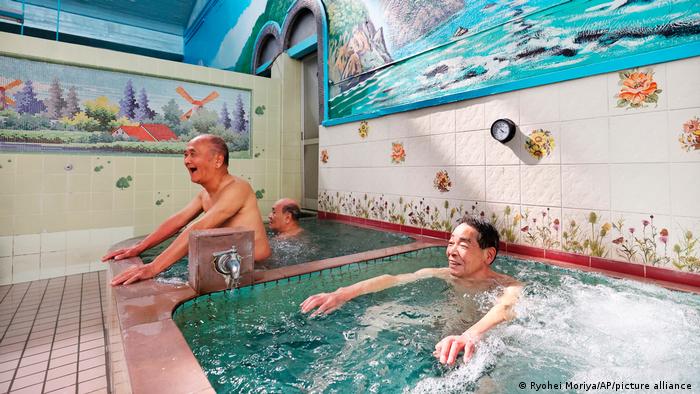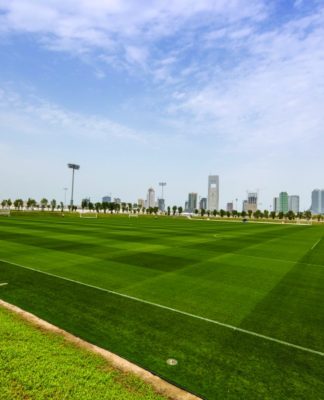ASIA
Japan launches campaign to revive fading public bathhouses
For centuries, public bathhouses have been an integral part of local communities, but their number is falling as prices rise and more people take baths at home.
People enjoy traditional bathing at a public bath in Tokyo
Japan is a nation of aficionados who insist on the benefits of long soaks in very hot baths
Traditional bathhouses, known as “sento,” have been an integral part of Japanese communities for generations. But their popularity is now declining.
The fall in the number of sento has been particularly steep in the capital, Tokyo, where modernization has altered entire neighborhoods irrevocably and the thin chimneys that identified a local communal bath have been torn down.
Operators have been hit even harder in recent years as customers stayed away during the coronavirus pandemic and, more recently, as overheads began to creep up.
In an effort to protect the city’s sento culture — which goes a long way beyond merely taking a bath — the metropolitan government has introduced a coupon scheme to encourage people to pop into their local bathhouse.
“The number of sento in Tokyo is falling as fewer people use them,” Kenta Orihara, director of the city government’s Safety and Living Section, told DW. “We believe it is important to help sento operators as they are an important part of our heritage and culture.
Pandemic, rising costs
“The situation has become worse in recent years because of the pandemic and now costs for fuel, electricity and everything else are rising, which makes things very difficult for operators,” Orihara said. “We want to help them to preserve as many sento as possible in Tokyo.”
Interior of a Japanese public bathhouse, Sento
Many bathhouses in Japan are reminiscent of the years immediately after World War II
That will be a challenge. In December 1968, 2,687 public bathhouses were registered with authorities in greater Tokyo, which at the time was a city of just over 22 million people.
In December 2020, the Tokyo Public Bathhouse Association put the number at about 500, and, by April of this year, that figure had shrunk to just 476. Meanwhile, Tokyo’s population has grown to 37.3 million residents.
“In the past, few homes had their own bathroom so people used to go to the local sento, which was an important part of the community,” Orihara said. “It became the place for people to meet and talk and find out what was going on in their neighborhood.
“That has changed now, and all homes in the city have their own bathroom,” he said, “so there is less need for a shared bath space.”
To counter falling visitor numbers, the city launched the Tokyo 1010 scheme in July, providing downloadable Q-code coupons that provide free entry. Typically, a visit to a sento in Tokyo costs around 500 yen (€3.57, $3.47).
Traditional styles
Many bathhouses remain a throwback to a different era. They are made of wood and the architecture is from the years immediately after World War II. Many incorporate large, stylized paintings of Mount Fuji on their walls.
Play Video1:58 min
High energy prices weigh on Japanese public bath owners
Men and women bathers are segregated, and the temperature of the water is generally kept at about 42 degrees Celsius (107.6 degrees Fahrenheit). While that might seem a little hot, Japan is a nation of bathing aficionados and they insist that a long soak in a very hot bath is healthy as it causes the arteries to relax and expand, improving blood circulation.
Better blood flow delivers oxygen and nutrients to all the cells in the body and carries away waste products, aficionados say.
Heat also alleviates pain, while warming the body reduces the sensitivity of nerves, which can serve to alleviate backache, stiff shoulders and other aches and pains. Warmth also softens the collagen-rich ligaments that surround the joints, making them more supple and relieving joint pain.
But a visit to a sento goes beyond that, the bathhouse association insists, declaring on its website: “Sento have for centuries been a place where neighbors meet and different generations come together. People inside are literally naked. Somehow it lends itself to honesty, more direct communication and respect for each other as humans.”
“Many countries have bath traditions, but there is something very special about the Japanese sento.”
There is broad support for the initiative and anticipation that other towns and cities across Japan could introduce similar support programs for their sento, although there is also the fear that public bathhouses are an anachronism that will, sooner or later, fade away entirely.
A different generation
“I think it is a great idea as it is clear that the pandemic and rising prices have made things very difficult for a lot of businesses in the last couple of years,” said Yoko Tsukamoto, an academic who lives in the city of Sapporo.
People wearing protective face masks at a public bathhouse during the COVID pandemic
COVID restrictions made it difficult for Japanese people to visit public bathhouses
“But I think the bigger problem is that people of my generation, anyone in their 40s or younger, really do not go to a sento,” Tsukamoto said. “I like to visit spas, which are more luxurious, and ‘onsen’ hot springs are still popular, of course, but there is no need to go to a sento anymore.
“They used to be really important for every community in the past,” she said, “but Japanese society has changed so much since then.”
“I think the older generation will continue to go as it is a habit that they have had since their childhood, and it is probably important that these people get out, speak to their friends and use the sento as a sort of community center,” she said. “But once that generation has gone, it is sad to say that I do not think there will be much demand anymore.”
Edited by: Srinivas Mazumdaru
Date 01.10.2022
Author Julian Ryall (Tokyo)
Related Subjects Asia, Japan
Keywords Asia, Japan, Tokyo, bathing
Feedback: Send us your feedback.
Print Print this page
Permalink https://p.dw.com/p/4HWjT






























